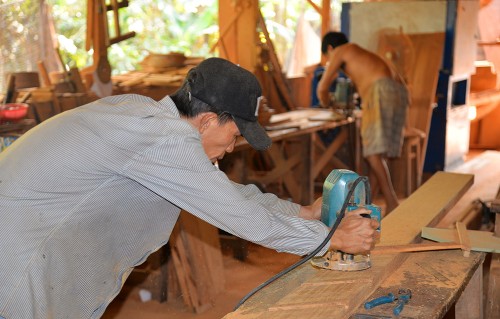 Carpentry requires meticulousness and dexterity to produce beautiful, precise products. (Photo: baoangiang.com.vn) Carpentry requires meticulousness and dexterity to produce beautiful, precise products. (Photo: baoangiang.com.vn) |
The sound of sawing, hammering, chiseling, and drilling and the smell of fresh-cut wood have characterized the carpentry village of the southwest for decades. Patience, ingenuity, and passion for the craft have enabled skilled carpenters to turn trees into tables, chairs, boats, and household items.
Southern forests contain precious woods like rosewood and barian kingwood that are made into altars, beds, tables, and chairs. More common types of wood are made into house timbers and boats.
Skilled craftsmen from the central and northern provinces migrated to the south to practice and teach their craft and established famous guilds in Ho Chi Minh City, as well as Lai Thieu ward, and Thu Dau Mot city in Binh Duong province.
Cho Thu craft village, established in 1892 in Long Dien A commune, Cho Moi district, An Giang province, is the southwestern region’s best-known carpentry village, with 1,000 facilities employing 2,000 workers. It has become famous for its altars, wardrobes, tables, and chairs. In 2006, Cho Thu village was officially recognized by the provincial People's Committee as a traditional craft village.
A local resident named Tran Minh Doan said Cho Thu products are characterized by sophistication mixed with rustic features. Local wood carvers don’t use machines because they believe that no matter how precise a machine may be, it’s never as good as a person’s hands and brain.
Doan told VOV that the 100-year-old Cho Moi area has five carpentry villages. Trading has become a little different from in the past. “Now some establishments make products while others distribute them to other provinces. Most are small and have only been in the business for a few decades. Others have been passed down from generation to generation. They make interior decorations or whatever is ordered,” said Doan.
 (Photo: baoangiang.com.vn) (Photo: baoangiang.com.vn) |
Ba Dai boat building village in Long Hau commune, Dong Thap province, is a craft village that has a special place in the hearts of south westerners. The century-old village was officially recognized by the Ministry of Culture, Sports and Tourism as a national intangible cultural heritage in 2015.
Nguyen Van Tot, known as Bay Tot, says local carpenters continue the craft, not just for economic reasons, but because they feel it’s their responsibility to keep the craft from disappearing. According to Tot, “There’s a saying: Having a lot of land is not as good as having a job. I’m the 4th generation in my family engaged in this craft. You need to have a passion for it, otherwise you can't do it.”
Nguyen Minh Toan, a carpenter in Ca Mau province with decades of experience, says he began learning the craft when he was 14. It took him about eight years to become a skilled worker. “Carpentry requires meticulousness and dexterity to produce beautiful, precise products,” said Toan, adding, “Many people try to learn but eventually fail because they lack manual dexterity and attention to detail. In the past, everything was done by hand so it took half a month or more to complete a sofa, for example. With a chiseling machine, it only takes two or three days to complete the same sofa.”
Many people pursue carpentry because they love the craft and want to keep it alive and preserve its unique regional character.